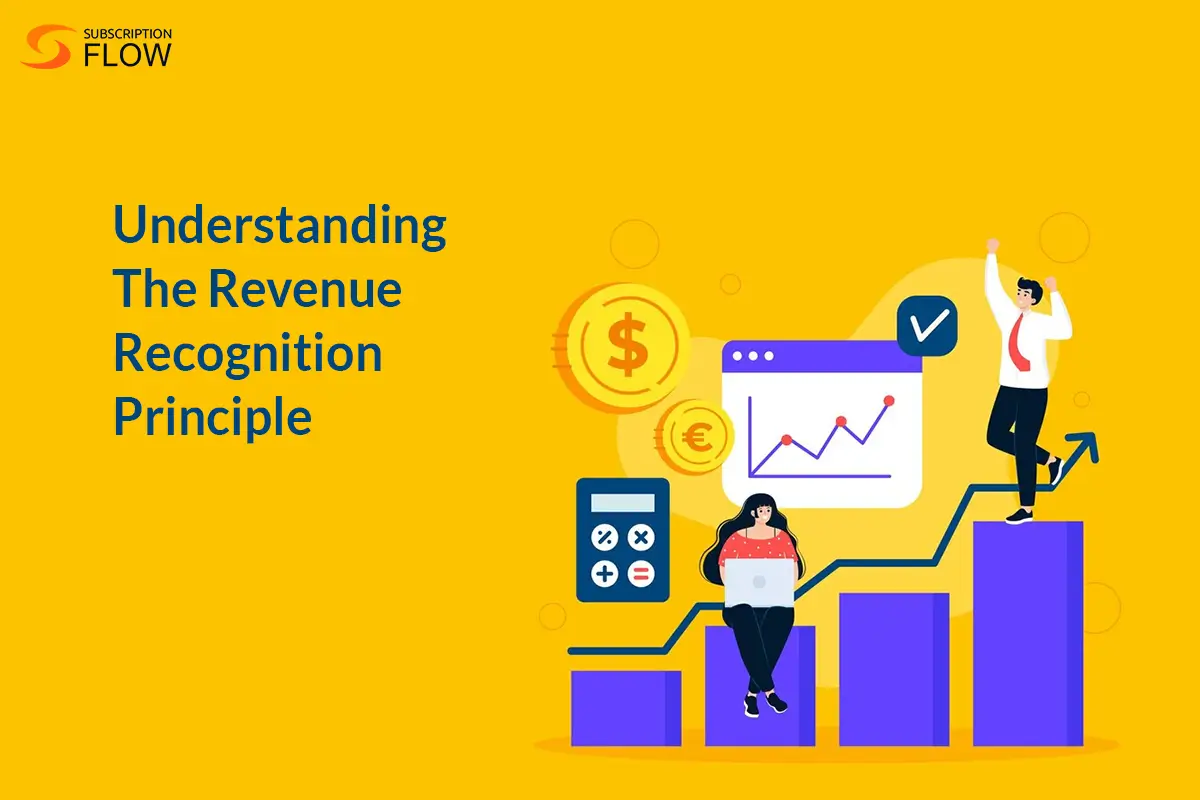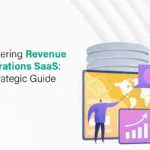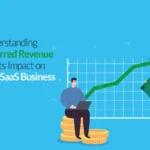
Understanding The Revenue Recognition Principle
Revenue recognition is a reflection of the accrual accounting principle. Accrual accounting states that revenue must be counted when it is earned, rather than when payment is received at your end. Cash is not equivalent to revenue. Revenue is earned only when a company fulfills its obligations toward its customer.
Revenue Recognition Principle Example
To grasp the concept better, let us take the example of a SaaS subscription-based company. If a customer makes an upfront payment for a 12-month subscription plan, that entire payment will not be recognized as the company’s revenue. That is because the company has not completed its duty to the paying customer yet, i.e. the provision of their service for 12 months. This duty would be fulfilled over the span of 12 months. Revenue would be recognized each month when the company will renew its service’s access to the customer. By leveraging SaaS revenue recognition, the companies can accurately match their revenue with the services they have provided.
Does Revenue Recognition Resonate with You?
If you are a business dealing with recurring revenue, for instance, in the form of recurring subscriptions, then following the revenue recognition principle is ideal for you. Here are some key benefits that come with leveraging this principle:
- Your business is in compliance with the internationally accepted financial regulations.
- You can analyze your profits and losses more accurately since you won’t be counting revenue as soon as you receive a monetary transfer.
- You can maintain financial transparency by presenting precise financial statements.
- You can better determine your business’s financial health by tracking revenue changes over time. It allows you to make intelligent decisions for company’s future success.
Revenue Recognition: The Five-Step Model
In the past, there was no standardized revenue calculation method. Each industry had its own accounting policies, which led to incoherent and fragmented revenue recognition practices. These policies were difficult to implement. They also posed a challenge as to how a comparison between the performance of different companies across industries was to be done.
That is when the international financial regulation bodies intervened. The revenue recognition principle is a generally accepted accounting principle (GAAP). Companies are required to adhere to this standard practice by Financial Accounting Standards Board (FASB) within the US. In order to develop shared regulation internationally, the FASB collaborated with the International Accounting Standards Board (IASB). Together they defined accounting standards for public companies across 144 countries. The joint regulations created by the FASB and IASB are known as ASC 606 (specifically in the US) and IFRS 15 (globally). These regulations have set a standard revenue recognition method across different business models. The regulations are relevant to all the companies which deal with their customers on a contractual basis in order to exchange goods or services with them. They can be private, public or non-profit.
The joint policies presented in ASC 606 and IFRS 15 endorse a five-step revenue recognition model which the companies are obliged to follow.
Step 1: Identify the Customer Contract
A contract is an agreement between your company and the customer which is legally binding. This contract can be written or verbal. In order to recognize your revenue, you must first identify this contract.
There are some requirements that a contract must adhere to in order to be binding:
- The time period of the contract must be made clear.
- The payment terms must be properly defined.
- The rights and obligations should be clearly stated.
- The contract must have commercial substance.
- Collection of the payment should be probable.
In the case of a point-of-sale purchase in a retail store, the receipt would stand in as the customer contract. On the other hand, in the case of online service based businesses the invoice would act like the customer contract. It would be embedded with the terms of service or subscription details.
Step 2: Identify the Performance Obligations
A performance obligation is the promise of the exchange of goods or services made in the customer contract. In a single customer contract, there maybe two or more than two performance obligations that need to be identified. For instance, a company has promised to give out a free gift subscription for purchasing their monthly subscription plan. The said company would have two performance obligations towards their customer who buys their monthly plan:
- The monthly subscription service
- The free gift subscription
For a service to be considered a different performance obligation, it needs to be ‘distinct’. Which means it needs to be a separate item or service on the invoice. So that your customer benefits from that service separately from the other services in the contract. In the above-mentioned example, the free gift subscription is a service distinct from the standard monthly subscription service that the customer would avail. Hence the free gift subscription would be considered the second performance obligation in the customer contract. Thus for a service to be identified as a performance obligation, it needs to fulfill two criteria:
- The service must be capable of being distinct so that the customer can benefit from it independently.
- The service must be distinct in the context of the contract, i.e. it should be easily identifiable as a separate entity in the customer contract.
Step 3: Determine the Transaction Price
The transaction price is the payment that a company expects in exchange for their goods or services. It is independent of the amounts that accumulate due to the involvement of third parties, such as the sales tax. In order to convey the transaction price and terms clearly to the customer, these points must be considered:
- The transaction terms must always be transparent. All the costs and charges should be stated without ambiguity.
- If there are customer rights, they should be clearly stated. Such as the right to return, the right to cancel the contract, or any potential discounts.
In the case of a SaaS based business, for example, the transaction terms would be well-defined if the customer rights are explicitly stated. Such as a refund promise if the customer is not satisfied with the service provided.
Step 4: Allocate Transaction Price to Performance Obligations
Each performance obligation should have its own transaction price defined. It is a simple process if the transaction price of each service is based on its stand-alone price. If there are variable considerations such as discounts, partial refunds, incentives etc., the transaction price would be determined by the expected value of the service.
Step 5: Recognize Revenue When Performance Obligations Are Fulfilled
Finally, the company’s revenue is recognized when it fulfils its performance obligations. In other words, revenue recognition occurs when the ‘transfer of control’ takes place. That is, when your customers gain control over your asset or utilize your service.
In the case the customer has paid you in advance, you cannot count that payment as your ‘revenue’. That is because this customer has yet to benefit from your services. It will be known as “deferred revenue” until the customer begins receiving the service.
Revenue can be recognized either at a point in time, or over time. For SaaS subscription-based businesses, once a customer makes a subscription, the revenue will begin to be recognized when the business would give them the access to their service. This access will be time-limited, for instance a monthly subscription. In this case, as the service is delivered by the company over the span of one month, its revenue would be recognized over that month accordingly.
How SubscriptionFlow Simplifies Revenue Recognition for Subscription Businesses
For SaaS subscription businesses, revenue recognition and calculation can seem tricky considering the flexible nature of subscription plans. You would need to keep upgrades, downgrades, prorations and cancellations in check for an accurate appraisal of your revenue. SubscriptionFlow’s revenue management software is here to ensure that you recognize your revenue accurately, and boost your financial transparency. SubscriptionFlow warrants that you have a steady and predictable revenue stream through:
- High-velocity subscription handling
- Real time reporting and forecasting
- Adjustment to changes in accounting regulations
- Automatic generation of customer reports
- Automated retention management
Book a demo with SubscriptionFlow to assess your transactions and payment terms conveniently, and get a complete picture of your revenue.
Conclusion
The revenue recognition principle specifies how and when a business recognizes its revenue and records it on its financial statements. It states that revenue must be recognized only when a company fulfills its performance obligations toward its customer. Not when the payment is made by the customer. Through this definition, the revenue recognition principle promotes financial transparency. It also makes it convenient to compare the performance of companies across industries. For businesses dealing with subscriptions, SubscriptionFlow is an ideal subscription management software which gives you an accurate appraisal and forecasting of your company’s revenue.









